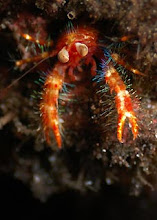
Classifying the Types of Snakes
According to current scientific classification (which is constantly being revised, by the way), there are somewhere between 2,500 and 3,000 snake species around the world. With so many types of snakes in the world, a good classification system is a must!
Snakes are grouped by the same scientific classification that applies to all other animals. Snakes are part of the Squamata order of reptiles -- an order that also includes most lizard species. All types of snakes fall into one of 18 families within the Squamata order, and each snake family is further broken down into genus and species.
Let's look at an example to clarify things. Here is the scientific classification of the western diamondback rattlesnake (starting at the class level):
Western Diamondback Rattlesnake- Class - Reptiles
- Order - Squamata
- Suborder - Serpents
- Family - Viperidae
- Subfamily - Crotalinae
- Genus - Crotalus
- Species - Crotalus atrox
Thus, the western diamondback rattlesnake is a species of snake within the Viperidae family -- venomous types of snakes that also include vipers and adders.
As stated previously, there are currently 18 families of snakes around the world. But this number is often argued and disputed, because the scientific classification of reptiles (including snakes) is constantly in flux.
CLICK HERE see snake and baby video clip
Major Families of Snakes
Here are the five families of snakes that account for the majority of species: - Colubridae -- The Colubridae family of snakes (known as colubrids) is by far the largest family, accounting for nearly two-thirds of the world's snakes. The vast majority of colubrids are non-venomous, though a few rear-fanged colubrid species are able to produce venom (such as the lyre snake of California). But even the venomous members of the Colubridae family are considered harmless to humans. So it's safe to say that colubrids, as a whole, pose no threat to humans.
- Boidae -- The Boidae family of snakes (known as boids) includes python and boa species. The three largest types of snakes in the world -- the anaconda, the reticulated python, and the African rock python -- are all members of the Boidae family. But smaller species like the royal python / ball python are also found in this family of snakes. All boids are non-venomous, powerful constrictors. Thus, they rely on strength instead of venom to kill their prey.

- Elapidae -- The Elapidae family of snakes (known as elapids) includes cobras, mambas, coral snakes and taipans. All elapids are venomous, and some of the most venomous snakes in the world are found within this family. Elapids produce a neurotoxic venom that attacks the central nervous systems (breathing) of their prey).
- Viperidae -- The Viperidae family of snakes (known as viperids) includes rattlesnakes, vipers, adders and other species. All types of snakes in the Viperidae family are venomous. In the United States, most venomous snakes species fall within this family (including all rattlesnakes, the copperhead, and the water moccasin). The coral snake (and elapid) is one of the only venomous snakes in the U.S. that is not in the Viperidae family. Nearly all members of this family produce hematoxic venom that attacks the tissue and blood of their prey.
- Hydrophiidae -- As the name suggests, the Hydrophiidae family includes sea snakes. Most sea snakes are venomous, and some species produce an incredibly powerful venom, a drop of which could kill a grown man. Fortunately for humans, sea snakes are reluctant to bite unless provoked (though you should still leave them alone
LINKS TO SEE
TIPS TO MAKERose garden
Jewels that change u>>>DAZZLING BEAUTY
KERALA...Tourism we enjoy......click here
Free furnitures
SCARY WEBSITES FOR U
Ghost gossips.....SCARY TO SEESnappy snakes>>SCARY VIDEO CLIPS BABY AND SNAKE
Friday, June 20, 2008
snappysnakes
Subscribe to:
Posts (Atom)

